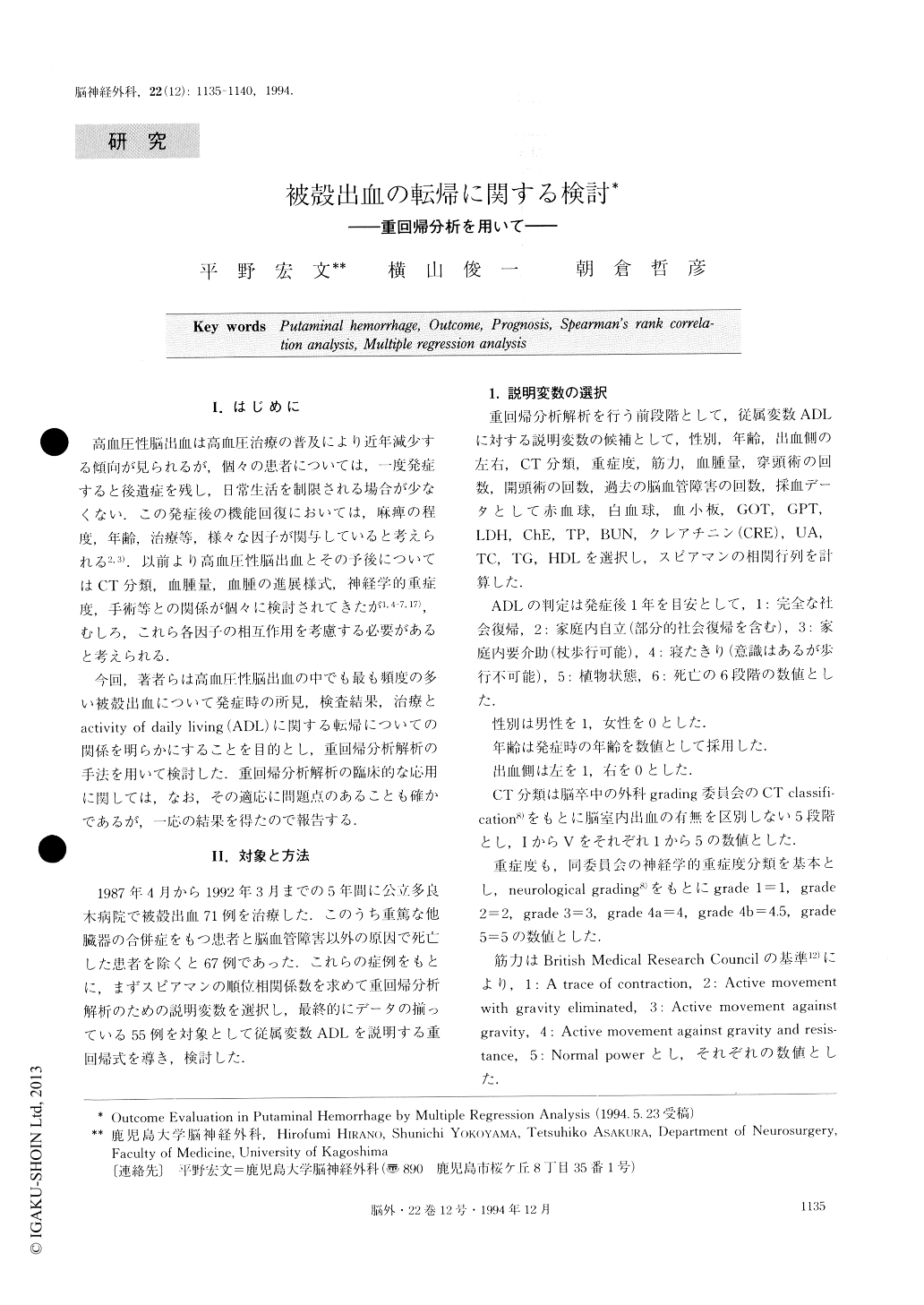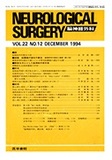Japanese
English
- 有料閲覧
- Abstract 文献概要
- 1ページ目 Look Inside
I.はじめに
高血圧性脳出血は高血圧治療の普及により近年減少する傾向が見られるが,個々の患者については,一度発症すると後遺症を残し,日常生活を制限される場合が少なくない.この発症後の機能回復においては,麻痺の程度,年齢,治療等,様々な因子が関与していると考えられる2,3).以前より高血圧性脳出血とその予後についてはCT分類,血腫量,血腫の進展様式,神経学的重症度,手術等との関係が個々に検討されてきたが1,4-7,17),むしろ,これら各因子の相互作用を考慮する必要があると考えられる.
今回,著者らは高血圧性脳出血の中でも最も頻度の多い被殻出血について発症時の所見,検査結果,治療とactivity of daily living(ADL)に関する転帰についての関係を明らかにすることを目的とし,重回帰分析解析の手法を用いて検討した.重回帰分析解析の臨床的な応用に関しては,なお,その適応に問題点のあることも確かであるが,一応の結果を得たので報告する.
The aim of this study was to determine the factors that influence the prognosis of hypertensive putaminal hemorrhage. We investigated the outcome of the activ-ity of daily living (ADL 1: full recovery at social life, 2: self cared, 3: required partial care at home, 4: remained bedridden, 5: vegetative state, 6: dead) one year after the onset of putaminal hemorrhage in com-parison with initial data obtained on the day when it occurred. The following parameters were assessed: sex, age, side of hematoma, classification of computed tomography (CT) findings, neurological grade, degree of muscle power, hematoma volume, treatment, past history of cerebrovascular disease, and laboratory data.In 67 patients with putaminal hemorrhage, the rela-tionships among these parameters were examined using Spearman's rank correlation analysis. Additionally, in 55 patients (24 male and 31 female) with complete data from the day of onset, multiple regression analysis was performed. The data of muscle power were handled by the quantification method.
The result of Spearman's rank correlation coefficient indicated that the outcome had a positive correlation with age (correlation coefficient=0.375), CT classifica-tion (0.595), neurological grade (0.714), hematoma volume (0.689), a past history of cerebrovascular dis-ease (0.475), the white blood cell count (0.541), and the lactate dehydrogenase level (0.347). The outcome had a negative correlation with muscle power (-0.579) and the cholinesterase (-0.340). The index showing the correlation between the CT classification, neurolo-gical grade, muscle power and hematoma volume was so high that we could not use the data on CT classifica-tion and neurological grade for multiple regressionanalysis because of the problem of multicollinearity. Multiple regression analysis (multiple correlation coeffi-cient=0.9044, P<0.0001) showed that the difference between the actual and predicted outcome was less than one rank in 51 out of 55 patients. The regression coefficients determined by the model were 0.03 (age= years), 1.302 (muscle power=0), 1.709 (muscle power =1), 0.274 (muscle power=2), 0.909 (muscle power= 3), 0.563 (muscle power=4), 0.02 (hematoma volume=ml),-0.264 (hematoma aspiration),-1.189 (cranio-tomy and hematoma removal), 0.421 (a positive past history of cerebrovascular disease), 0.003 (lactate de-hydrogenase=IU/L), -1.461 (cholinesterase=ΔpH). Thus the model suggested that surgical intervention was effective for the treatment of hypertensive puta-minal hemorrhage. The lactate dehydrogenase and cho-linesterase level seemed to be related to outcome, be-cause the former indicates the general condition, and the latter indicates the nutrition level of patients. These results suggested the possibility of predicting the prognosis of hypertensive putaminal hemorrhage from clinical data and the method of treatment in the acute stage.

Copyright © 1994, Igaku-Shoin Ltd. All rights reserved.


